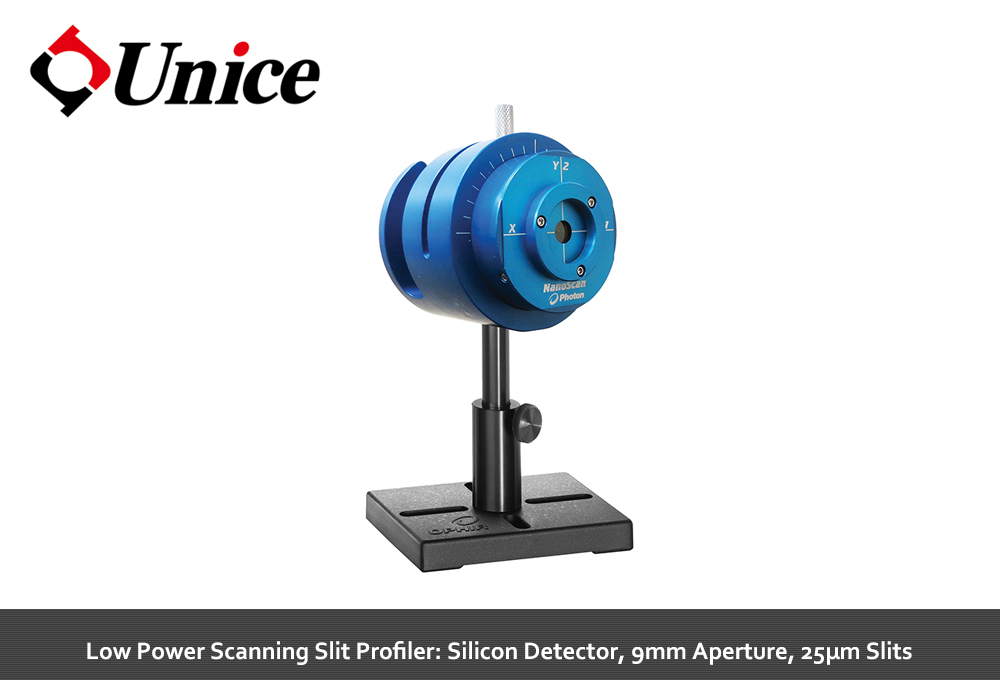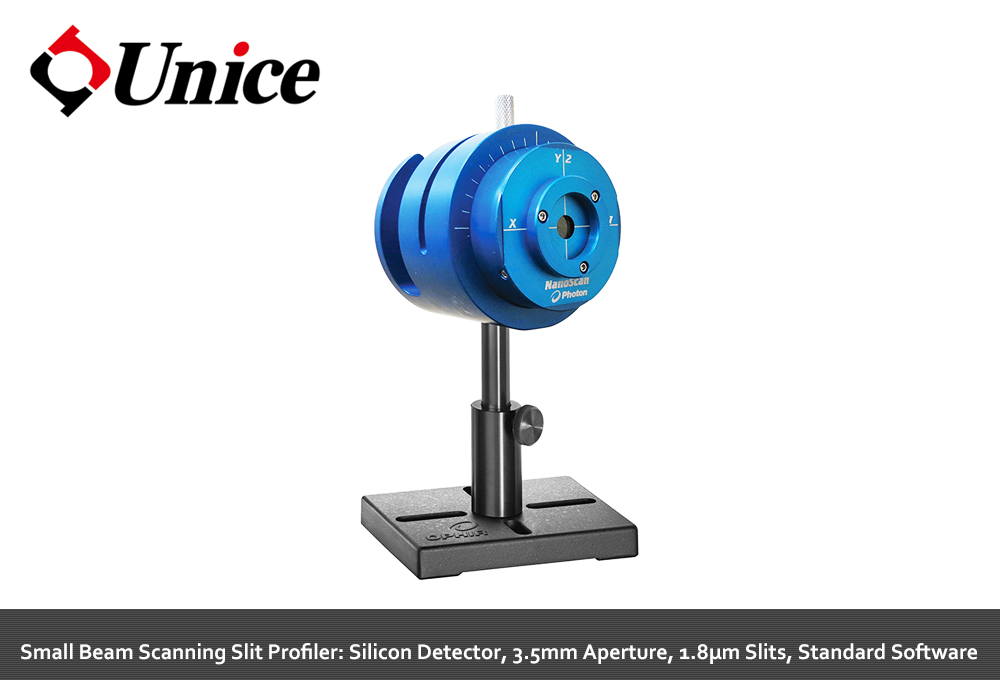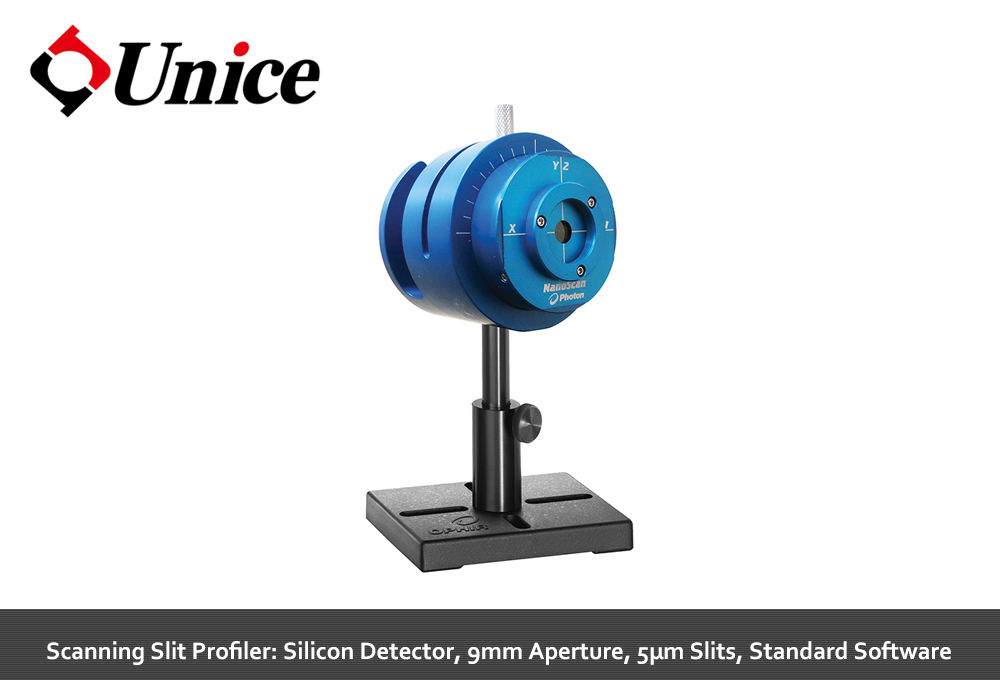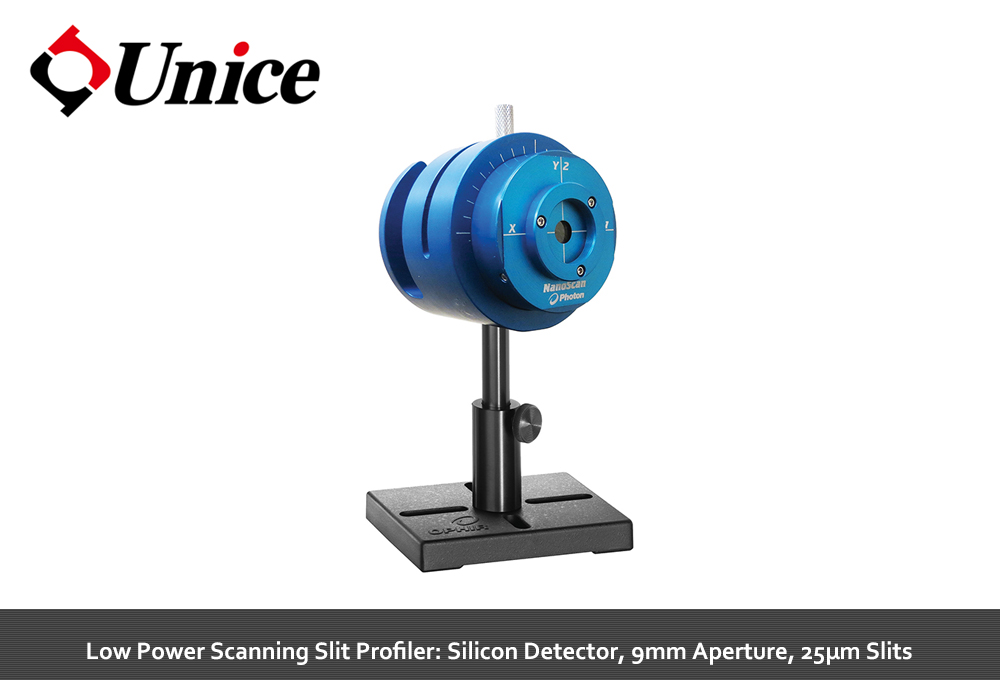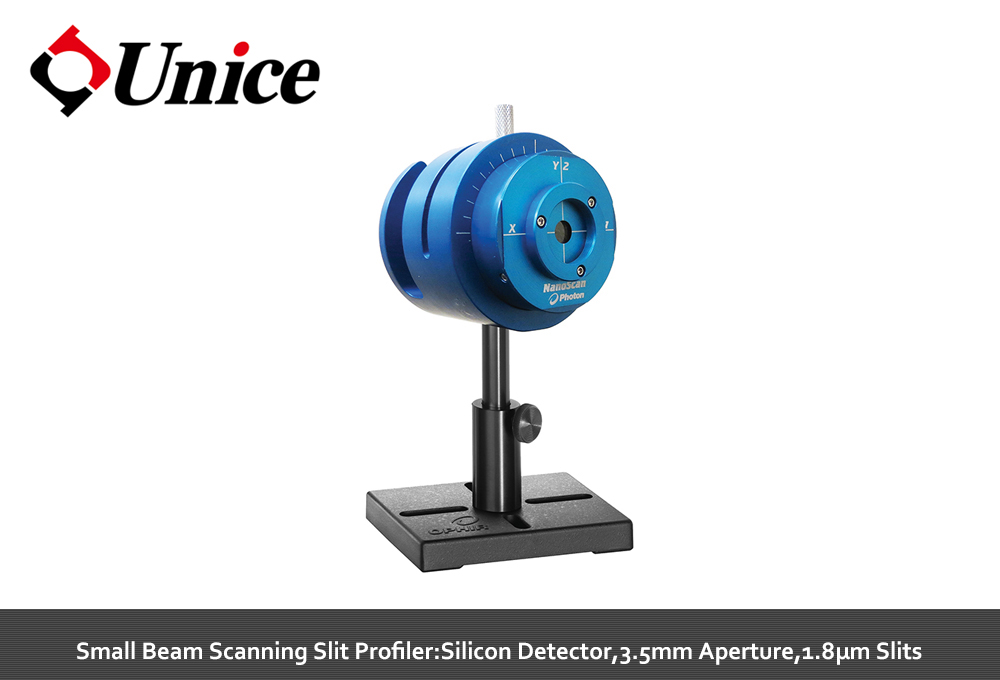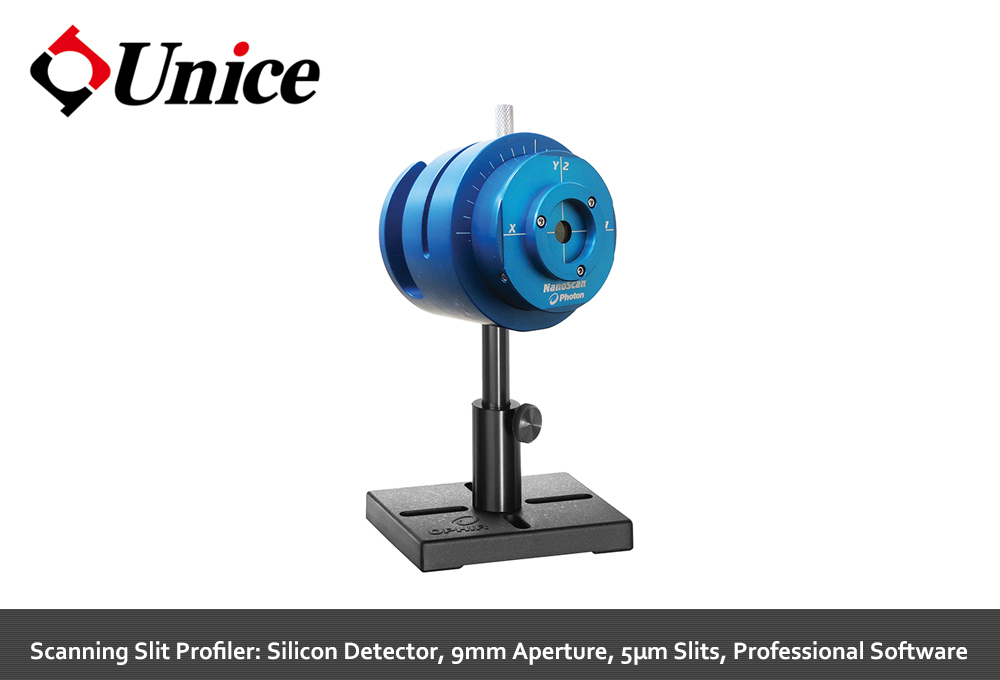| Model |
NanoScan 2s Si/9/25 |
| Sensor Type |
Silicon |
| Wavelength |
190 - 950nm |
| Power Range |
~10nW - ~10W |
| Beam Size |
100μm - 6mm |
| Aperture Size |
9mm |
| Slit Size |
25µm |
| Compatible Light Sources |
CW, Pulsed >25kHz |
| Scanhead Size |
83mm |
| Interface |
USB 2.0 |
|

DataSheet
|
Software – NanoScan 2s Professional Version
Scanning Slit Beam Profiler For High Accuracy Dimensional Measurement
NanoScan 2s combines the convenience and portability of direct USB connectivity with the speed, accuracy, and dynamic range that users have come to expect from the Photon NanoScan slit based profilers. The NanoScan 2s is available with a silicon, germanium or pyroelectric detector, which allows it to profile lasers of any wavelength
from UV to far infrared, out to 100μm and beyond. With the new NanoScan 2s software package, the user can configure the display interface however it is desired; displaying those results of most interest on one easy-to-read screen, or on multiple screens.
The NanoScan slit profiler is the most versatile laser beam profiling instrument available today: providing instantaneous feedback of beam parameters for CW and kilohertz pulsed lasers, with measurement update rates to 20Hz. The natural attenuation provided by the slit allows the measurement of many beams with little or no additional attenuation. The high dynamic range makes it possible to measure beams while adjustments to focus are made without having to adjust the profiler. Just aim the laser into the aperture and the system does the rest!
Capabilities
NanoScan 2s is a PC-based instrument for the measurement and analysis of laser beam spatial irradiance profiles in accordance with the ISO standard 11146. The scan heads also measure power in accordance with ISO 13694.
NanoScan uses the scanning slit, one of the ISO Standard scanning aperture techniques. It can measure beam sizes from microns to centimeters at beam powers from microwatts to over kilowatts, often without attenuation. Detector options allow measurement at wavelengths from the ultraviolet to the infrared.
The NanoScan 2s digital controller has 16-bit digitization of the signal for enhanced dynamic range up to 35dB power optical. With the accuracy and stability of the beam profile measurement you can measure beam size and beam pointing with a 3-sigma precision of several hundred nanometers. The software controllable scan speed and a “peak-connect” algorithm allows the measurement of pulsed and pulse width modulated lasers with frequencies of 10kHz and higher*. The NanoScan is also able to measure up to 16 beams, or regions of interest, in the aperture simultaneously.
Benefits
• Mֺֺeasure any wavelength from UV to very far infrared (190nm to >100μm)
• Iֺֺnstantaneous real time display of results; beam found in less than 300ms and updated at up to 20Hz
• Wֺֺaist location can be determined to within ±25μm due to the well-defined Z-axis datum plane of the NanoScan
• Mֺֺeasure pulsed and CW lasers
• Fֺֺor pulsed beams the pulse rate is measured and reported
• Fֺֺrom as small as 7μm beams, can be measured directly with guaranteed accuracy and precision
• Aֺֺdditional high signal to noise ratio can be achieved with averaging
• Zֺֺ-axis caustic measurements are available with built-in mechanical linear stage control
• Mֺֺ2 propagation ratio values available with simple M2 Wizard included with the software.
• Aֺֺny beam result can be charted and monitored over time
• Pֺֺower levels can be monitored along with spatial measurements to determine if losses are introduced by beam adjustments
• Lֺֺog results to text files for independent analysis
• Aֺֺutomate the system using optional ActiveX Automation commands, available with the PRO version software and scan heads Samples of automation programs included for Excel, VBA, LabView and Visual Basic.net
NanoScan 2s Configurable User Interface
In addition to new hardware, the NanoScan 2s has an updated integrated software package for the Microsoft Windows Platform, which allows the user to display any of the results windows on one screen. The NanoScan 2s software comes in two versions, STD and PRO. The NanoScan 2s Pro version includes ActiveX automation for users who want to integrate the NanoScan into OEM systems or create their own user interface screens with C++, LabView, Excel or other OEM software packages.
Integrated Power Meter
The silicon and germanium detector equipped NanoScan 2s systems include an integrated 200mW power meter. The scanhead comes with a quartz attenuator window
that provides a uniform response across a broad wavelength range.
This is a relative power meter that has better than 1.5% correspondence when calibrated with a user-supplied power meter and used in the same configuration as calibrated.
The power meter screen in the software shows both the total power and the individual power in each of the beams being measured.
Available Detectors
The NanoScan 2s is available with silicon, germanium or pyroelectric detectors to cover the light spectrum from UV to very far infrared.
Apertures and Slits
The NanoScan 2s is available with a variety of apertures and slit sizes to allow for the accurate measurement of varying beam sizes. The slit width defines the minimum beam width that can be measured; due to convolution error, the slit should be no larger than ¼ the beam diameter to provide a ±3% accurate measurement. For this reason the minimum beam diameter measureable with the standard 5μm slit is 20μm. To measure beams smaller than 20μm it is necessary to use the small aperture 1.8μm slit instrument, providing a minimum beam diameter of ~8μm. Because these slits are so narrow, the maximum length limits the aperture to 3.5mm. Contrary to many people’s beliefs, these smaller slits do not improve the resolution of the measurement, only the minimum size of the beam. Therefore, unless it is necessary to measure beams less than 20μm, one would be advised to stick with the 9mm/5μm configurations. For very large beams, NanoScan is available with a large 20 or 25mm aperture with 25μm slits. These sensor are larger than the standard scan heads (100mm diameter)
The Most Versatile and Flexible Beam Profiling System Available
With the available range of detectors, slit sizes and apertures the NanoScan 2s provides the maximum versatility in laser beam profiling. NanoScan 2s adds the convenience and portability of direct USB connectivity: no external controllers or power supplies required to operate the profiler. In addition the rotation mount has been redesigned to provide a stand for vertical operation, if desired. The mount can be positioned in one of two places. If vertical operation is desired the mount is positioned toward the back of the scanhead to expose the stand, which can be affixed to the optical table or stage. If standard horizontal operation is desired, then the rotation mount can be positioned in the forward configuration, maintaining the original length and size of the scanhead.
See Your Beam As Never Before
Measured Beam Results
From 1989 through 1996, John Fleischer, founder and past President of Photon Inc., chaired the working laser beam width ISO/DIN committee that resulted in the ISO/DIN 11146 standard. The final approved standard, available in 13 languages. The standard governs profile measurements and analysis using scanning apertures, variable apertures, area sensors and detector arrays. NanoScan 2s measures spatial beam irradiance profiles using scanning slit techniques.
Results measured include:
• Bֺֺeam Width at standard and user-definable clip levels, including 1/e² and 4σ
• Cֺֺentroid Position
• Pֺֺeak Position
• Eֺֺllipticity
• Gֺֺaussian Fit
• Bֺֺeam Divergence
• Bֺֺeam Separation
• Pֺֺointing Stability
• RֺֺOI Power
• Tֺֺotal Power
• Pֺֺulsed Laser Repetition Rate
M² Wizard
M-squared (M²) software Wizard is an interactive program for determining the “times diffraction limit” factor M² by the Rayleigh Method. The M² Wizard prompts and guides the user through a series of manual measurements and data entries required for calculating M². Used with a user-provided translation stage focusing lens and the M² Wizard in the NanoScan Analysis Software, the user can quickly and easily determine the times-diffraction propagation factor (M²) of a laser. For automated and automatic M² measurements the NanoModeScan option is required.
Pulsed Laser Beam Profiling
In addition to profiling CW laser beams, NanoScan can also profile pulsed laser beams with repetition rate in the 10kHz range and above. To enable the measurement of these pulsed lasers, the NanoScan profiler incorporates a “peak connect” algorithm and softwarecontrolled variable scan speed on all scanheads. The accuracy of the measurement generally depends on the laser beam spot size and the pulse-to-pulse repeatability of the laser. The NanoScan is ideal for measuring Q-switched lasers and lasers operating with pulse width modulation power (PWM) control. In the past few years, lasers with pico- and femtosecond pulse durations have begun to be used in many applications. Although these lasers add some additional complication to the measurement techniques, the NanoScan can also measure this class of laser.
Automation Interface
For customer who want to incorporate the NanoScan 2s into an automated procedure or to create a customized user interface, the PRO version scanheads include an ActiveX Automation Server that can be used by an Automation Client written in Visual Basic for Applications (VBA), C/C++ or by an application which supports ActiveX Automation, such as Microsoft Excel, Microsoft Word or National Instruments’ LabVIEW. The software package include example of programs written in Excel and LabVIEW in the automation folder.
Optional Collimation Fixture
Collimation is one of the most common applications for which the NanoScan 2s is used. The Collimation Fixture provides an easy and extremely accurate method for making this adjustment to a laser system.
The Collimation Fixture comprises a test lens with the NanoScan 2s profiler positioned to measure the beam size at the geometric focus of the lens. From lens theory, the angle of collimation is determined by the equation:
θ = Dƒ / ƒ,
where θ is the angle of collimation, Dƒ is the beam size measured at the lens focal length, and ƒ is the focal length of the lens. Once the beam size is measured at the focal length of the lens, simply dividing this measured beam size by the focal length determines the laser beam collimation angle. Practically speaking, adjusting the optics to generate the smallest Dƒ, will result in the minimum divergence angle. The beam profiler remains fixed, and active alignment is easily performed in real time. This level of
simplicity, speed, and functionality is simply not possible with techniques involving multiple beam profile positions. Divergence/Collimation test fixtures based on a high quality test lens to focus your collimated or diverging beam. Fixtures require a complete NanoScan System. Wavelength of use should be specified at time of order.
